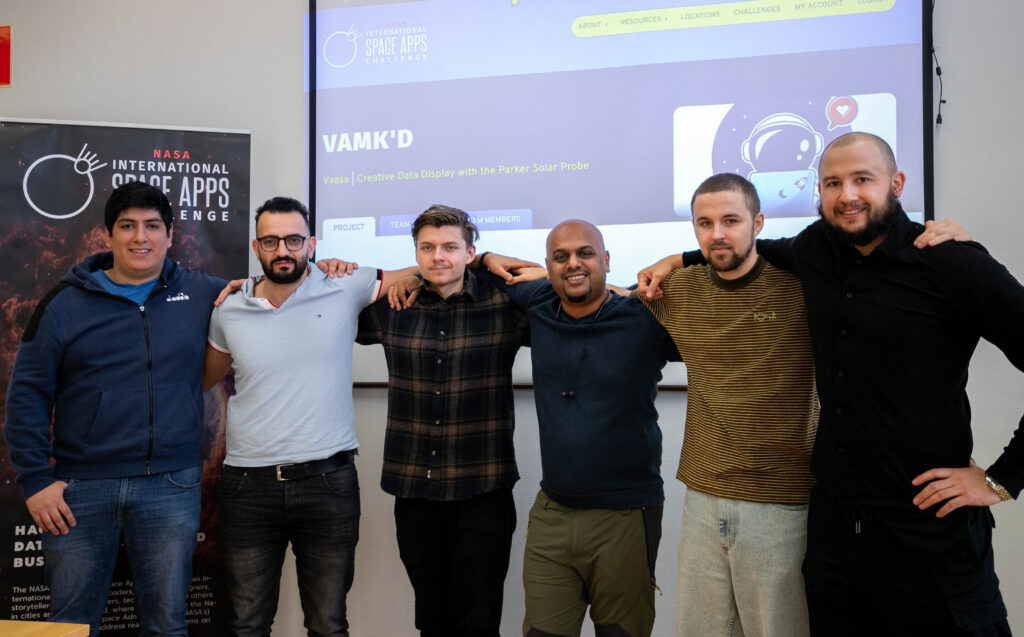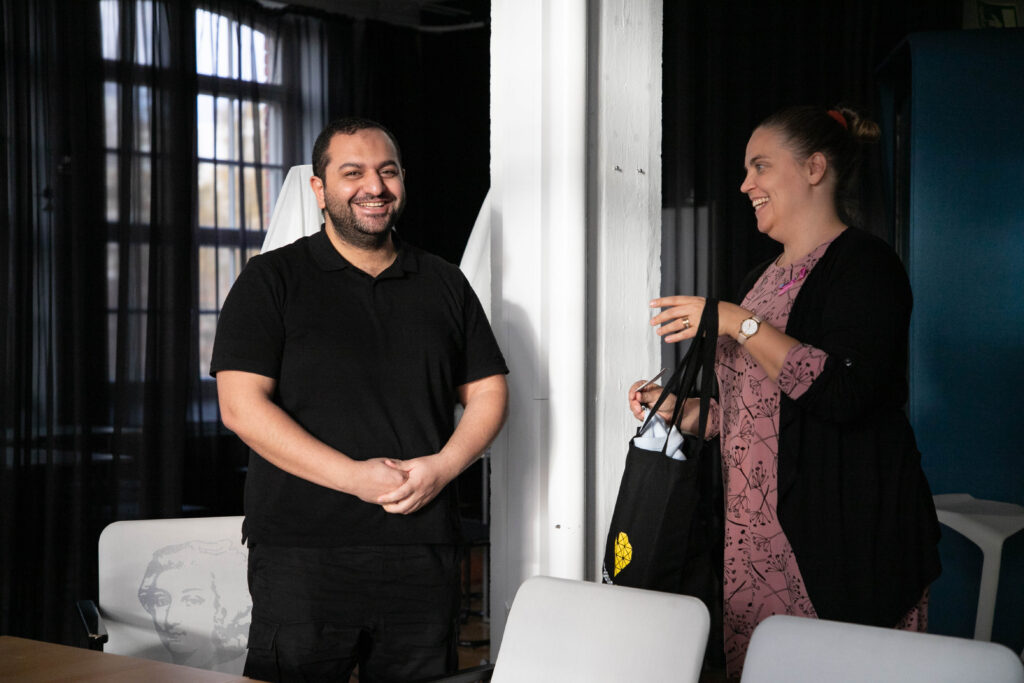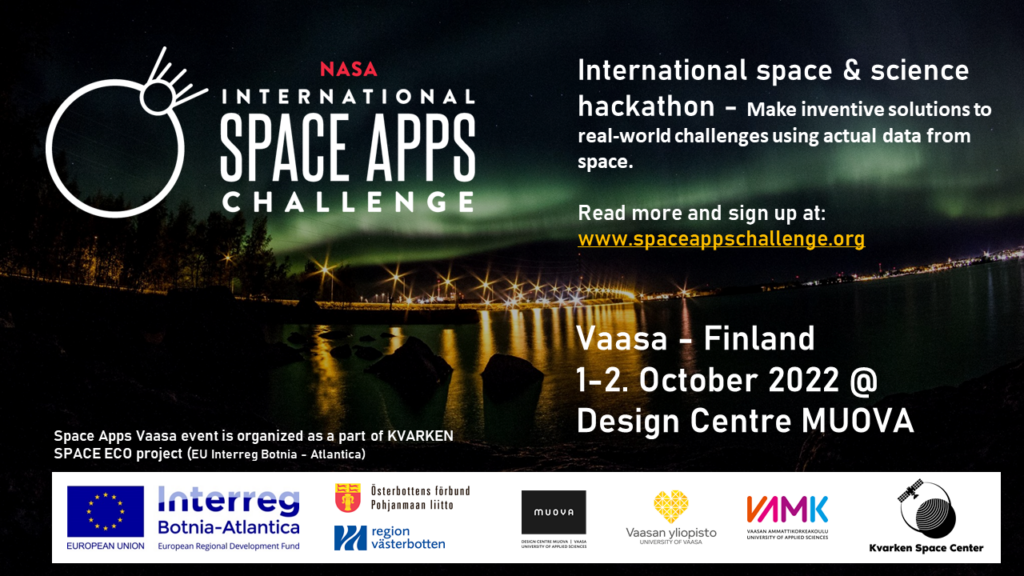
The winning team VAMK’d at the NASA Space Apps hackathon 2022 in Vaasa. Photo: Jari Ratilainen.
The Smallest and the Biggest Team Triumphed in NASA’S International Space Apps Challenge
Let’s take a moments and check the local winners of NASA’s International Space Apps Challenge that took place in the beginning of October in Vaasa. It was the 4th time KvarkenSpaceEco arranged this hackathon in Vaasa together with Design Center Muova and West Coast Startup.
Professor Heidi Kuusniemi, Director of Digital Economy, and a member of jury explained jury’s perspective to the hackathon in this way:
“We were very happy in the jury about the broadness of the entries, and which challenges teams decided to tackle. Most of the teams had utilized the given material from NASA and all the resources very well. They had innovative ideas on how to form solutions to the given challenges. I was also delighted that they had utilized the European Space Agency material and references, in addition to the repositories and materials given by NASA. It was a good mixture of theoretical and scientific input. There were also very practical and fun elements in many of the teams outputs. You could see that the teams had a good time while they were making their solutions.”
For the future hackathons her advice to the teams is to follow the instructions very thoroughly and do the homework of the content of the challenges.
“To be very clear on what is the challenge about, what’s the essence, what’s needed, what’s the current gap, why has this challenge been created. Finally, try to consider if your planned solution can answer to all that.”
And the winner is…
Team VAMK’d (members Kunal Menon, Ali Aldulaimi, Sergiu Petrut, Mykola Zhabko, Gonzalo Araya, Bogdan Rudnevskii) won the NASA’s international space challenge in Vaasa, and became a global nominee. The team was working on the Creative Data Display with the Parker Solar Probe and their solution included information website, smart home integration and interactive 3D game.
During the hackathon Kunal told: “We joined this competition because we were looking for a challenge. We wanted to see what we have learned, and how we can apply our knowledge in a short period of 2 days.”
It was obvious that the time given was very short, and the team members didn’t get much sleep during the weekend.
According to Ali, most challenging was the amount of time to deliver, which was very short. Still, he is happy he joined and experienced new things that are out of the regular school curriculum.
“Maybe this experience will help to find the job in the future,” he wondered.
After the award ceremony, the winning team expressed their overall feelings about the hackathon:
“Team members are excited, we are very happy and lucky that we won, and we are looking forward to the next opportunities to participate in competitions or hackathons in Finland,” said Bogdan.
“This hackathon was a great learning opportunity, it also helped to see where our boundaries are and where our strength lies,” Sergiu added.
Ali expressed his feelings about the winning competition: “I would say I feel really great and motivated at this moment and it was a really good opportunity to participate in this challenge, I haven’t participated before, and right now I feel more motivated. It was really fun, fantastic and gorgeous challenge that we went through.”
”I’m so happy of the results because we did a lot of stuff in short time and I’m happy of how we worked as a team. I’m looking forward to be working in some hackathon in the future as well,” declared Gonzalo.
Mykola said he is very excited about the result and the process how it was. “Everything was so unexpected. Few days before hackathon we decided to have a team and to choose the challenge,” he recalled.
He also admitted that they had some difficulties during the hackathon. For example, when making the game with Gonzalo they had to proceed learning by doing and googling since the technology was new for them.
The team project manager Kunal wanted to thank Jari Ratilainen for the great opportunity to participate in the hackathon. “It was like out of the blue, we literally saw him in our cafeteria and that’s how this idea came about.”
The winning team wanted to help people understand the importance of space weather. The Sun or the space weather affects to everything from your mobile phone to your bank account since everything uses satellite data.
“It was a very challenging and tiring brain fight for two days but it was very rewarding. We didn’t really expect to win because this was our first hackathon, but it was a great experience overall.”
Story of the one-man team

Mahmoud Elsanhoury and Heidi Kuusniemi at NASA Space APPS reward ceremony. Photo: Jari Ratilainen.
Mahmoud Elsanhoury won the “Local People’s Choice Winner” award by implementing in 3D view a live tracker of the international space station.
This is how Mahmoud told about his journey at the hackathon:
“Many thanks for professional organizing of the NASA Space Apps event. It feels great to receive recognition from people, it means that they appreciate something that you have done, and that is very rewarding.
Actually, I never thought that my submission would count at all, nor be assessed further in this competition, for many reasons. Firstly, at the competition there were many great teams working tirelessly to build their apps and solve the challenges. I liked some of their contributions already. Secondly, our team’s size got shorter due to the busyness of its members. Therefore, instead of being three members it got down to one active member that works on the challenge, and one helping member who assists all teams with problem solving. I remember being called “the lonely guy” by my colleagues at the competition venue, which was very humoring. I even discarded the team photo because technically there was no team. Third and foremost, the challenge itself was challenging, I recall seeing some teams quitting on doing that particular challenge because it was very time-consuming and required heavy programming skills. Going through that situation, I thought I am not going to produce anything in this challenge.
But I took it as a personal challenge, even if it seemed trivial task for experienced programmers but I said it is very negative to quit on a challenge. There was nothing to lose, I said I am going to break the challenge to very small blocks, then attempt those tiny blocks bit-by-bit and solve every step separately. The rest was Godspeed.
After day one, I was able to setup the web page, purchased the domain server and hosting space, included the backbone libraries for the website, and set the scene for 3D modelled Earth, Sun, Stars, and the international space station (ISS). On the second day of the challenge, I was able to insert the 3D models after modifications, import some Earthly details (e.g. night and day regions), trace the space station (ISS) in real time, and the final step was to refine the movement of the station. At that time I received help from my helping colleague to remove the redundant 3D models while moving, which was perfect. Then it became a matter of extra detailing the output to leverage the visitor with more information about the 3D live tracker.
It is kind of inspiring to wade in a challenge without prior experience, and yet, accomplish the objective. One week ago, I never coded in JavaScript or JSON, never used Blender for 3D modelling (I am more used to 3D Max-studio but by competition guidelines; the tool had to be opensource). But now, I have learnt a great deal on how to develop simple web applications with simple UIs, in addition to build interactive 3D graphics online, thanks to this hackathon.
I got motivated to pursue this particular challenge since I am already working in the field of localization and tracking. I usually use other technologies to track robots and/or personnel in industrial venues but only through algorithms and telecom-based devices such as Ultra-wide-band, Wi-Fi, and GPS. So, it was very nice to finally get some rest from writing algorithms and equations and go to sketch some nice user interfaces to visualize the tracking for the public in a user-friendly environment.”
Author: Vaiva Stanisauskaite
